Indianapolis LASIK Eye Surgery
If you’re ready to take off your glasses for the last time or toss away your contacts forever, laser corneal refractive surgery in the form of LASIK or PRK can make it possible. With the combination of our premier team of Indianapolis LASIK surgeons and the most advanced technology, schedule your consultation and start taking your steps towards clear vision today.
Say Goodbye to Eyeglasses and Contact Lenses
Whether it’s PRK or LASIK, the magic of the cool laser beam lies in its ability to precisely change the curvature of the cornea by just microns—literally thousandths of a millimeter. Light can then be properly focused on the retina to create a new corneal curvature, which can correct many conditions that otherwise warrant glasses and contacts. Offering premier LASIK eye surgery procedures to our clients throughout the Greenwood and greater Indianapolis areas, our team of eye doctors makes sure you get the full benefits from your procedure.
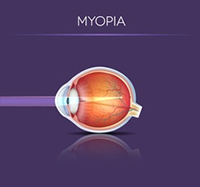
LASIK for Nearsightedness
Nearsighted people see objects clearly up close but struggle to see objects in the distance. In nearsightedness, the curve of the cornea is too steep, and images are focused in front of the retina. LASIK & PRK corrects this condition by flattening the curve of the cornea.
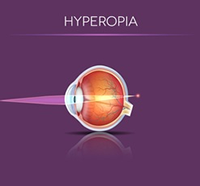
LASIK for Farsightedness
Farsighted people see distant objects clearly, but all other objects appear blurred. In farsightedness, the shape of the cornea is too flat, and light rays are focused behind the retina. LASIK & PRK corrects this condition by shaping the cornea so that it focuses correctly.
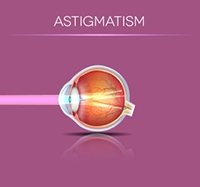
LASIK for Astigmatism
People with astigmatism are unable to focus clearly at any distance. With astigmatism, the cornea is abnormally shaped, much like that of a football, when a rounder, more basketball-like shape is desired. LASIK & PRK corrects this oval shape by rounding the cornea to achieve clearer vision.
Traditionally, LASIK was performed with a microkeratome—essentially, a surgical instrument equipped with a blade to remove the corneal flap from the eye. However, ophthalmologists have found that when complications do arise following a LASIK procedure, they’re often due to a poorly created corneal flap, where precision with a blade is difficult. It’s why Lanter EyeCare uses only the latest, blade-free LASIK surgery techniques.
Known as IntraLase technology, blade-free LASIK’s IntraLase laser can be programmed with the exact dimensions of your corneal flap—precisely customized to the unique characteristics of your eyes. The IntraLase laser is also able to create your flap from below the surface of your cornea, with no blade and no cutting. Here’s how it works:

- Ultra-fast pulses of laser light place microscopic bubbles at an exact depth predetermined by your ophthalmologist. (This laser light passes harmlessly through your cornea.)
- The laser creates rows of these bubbles just beneath your corneal surface, moving back and forth across your eye in a uniform plane.
- The laser stacks the bubbles around your corneal diameter—custom to the shape of your eye—to create the edges of your flap.
- The ophthalmologist gently lifts the flap, separating the tissue where the bubbles have formed.
- With the corneal tissue exposed, the ophthalmologist uses an excimer laser to reshape the cornea in a specific pattern unique to the patient.
- With the treatment complete, the flap is gently placed back into a position to heal. It’s extraordinary bonding properties allow healing to occur naturally, without stitches.
Common LASIK Questions
Q: Is LASIK painful?
A: Most people experience no pain throughout their LASIK eye surgery, however, patients will experience a mild discomfort primarily during the flap creation part of the process. After the surgery, some people do report irritated eyes or slight discomfort.
Q: Has anyone ever gone blind from a Laser Vision Correction Procedure?
A: At this point in time there have been zero reported cases of a total loss of vision.
Q: Is all LASIK eye surgery the same?
A: There are various types of laser vision correction and LASIK eye surgery. If you would like a more detailed explanation of the various types of LASIK eye surgery please visit our webpage on how LASIK works. Common types of LASIK eye surgery you may have heard of include: LASIK, LASEK, PRK, Advanced Surface Ablation, IntraLASIK, Blade-FREE LASIK, iLASIK, ladar vision, allegretto LASIK. Laser vision correction is typically performed by the same standards but technology
Q: Are laser vision correction procedures covered by insurance?
A: Few insurance policies cover Laser Vision Correction, however, we would be happy to check yours when you come in for a consult. Remember patient financing plans are also available. We use Care Credit with 0% Financing Options.
Q: What if I blink during the LASIK eye surgery?
A: This is a very common question and we tell our patients to not worry about this. A LASIK speculum will be used to keep your eyelids held back. There will be no physical way that your eyelids will be able to blink.
Q: Can both eyes be done at the same time?
A: In the majority of all cases, both eyes are done at the same time. But you may elect to have one eye done at a time.
Q: “Why not go to a discount Laser Vision Correction center?”
A: With laser vision correction, safety, outcomes, and patient satisfaction should be the deciding factor behind the center you choose, not cost.
Q: “Is Laser Vision Correction for everyone?”
A: Laser Vision Correction is not necessarily for everyone. The best way to determine your candidacy is with a proper screening and thorough evaluation.
Q: “I am very busy at work. What type of time commitment is needed to have LASIK?”
A: This is a state-of-the-art procedure, which requires minimal time for the patient. The actual procedure lasts under 10 minutes per eye. Most patients can go back to work the very next day.
Q: Will I have 20/20 vision following laser vision correction?
A: While the overwhelming majority (98%) of our laser vision correction patients achieve corrected vision of at least 20/40 or better, the possibility of needing further enhancement surgery remains. This possibility varies among patients, depending on the degree of original refractive error. Laser vision correction enhancements at our Indianapolis and San Diego locations require no further payment from our patients within the first year of the original procedure.
20/20 is the current standard for excellence in vision. But, as shown in a clinical study, individuals undergoing the CustomVue™ procedure have the potential to see even better than 20/20. In fact, one year after the CustomVue™ procedure, nearly 70 percent of clinical study participants saw 20/16 or better.
- 100% of the clinical study participants could pass a driving test without glasses or contacts
- 98% of the clinical study participants could see 20/20 or better without glasses or contacts
- 70% of the clinical study participants could see 20/16 or better without glasses or contacts
In addition, many participants reported that they had clearer, better vision both during the day and at night, compared to their vision with glasses or contact lenses before the procedure.
What kind of laser is used for LASIK?
The Excimer laser is used in LASIK eye surgery to correct refractive errors by reshaping and polishing the cornea. The Excimer laser produces a cool ultraviolet beam that removes molecular layers of corneal tissue without damaging or burning the surrounding tissue. Each pulse removes only one-fourth of a micron, giving the Excimer tremendous precision. As a comparison, a human red blood cell is over thirty times as thick as the amount of cornea removed with one Excimer pulse. Most patients have their vision corrected while removing an amount of corneal tissue comparable to the thickness of a human hair. Originally invented to serve as a manufacturing tool for IBM computer chips, the Excimer laser’s potential for laser vision correction was discovered in 1983. During laser vision correction surgery, a computer programmed specifically for each patient controls the Excimer laser. LASIK has helped millions of Americans see without corrective lenses.
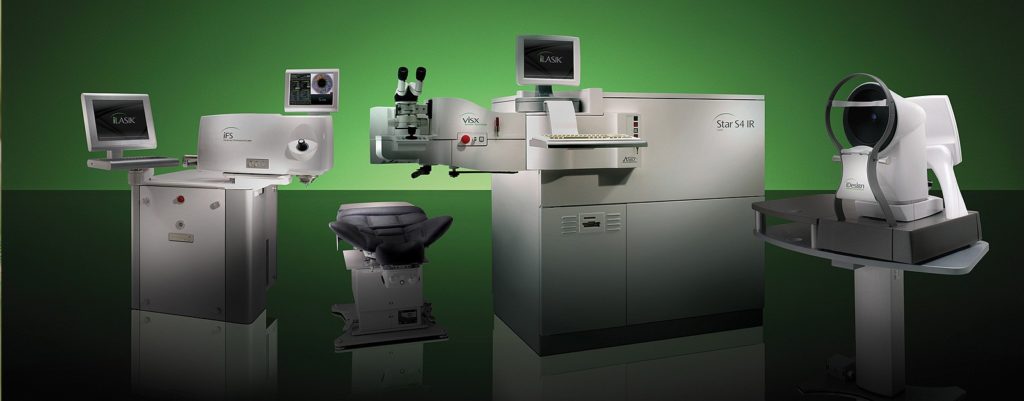
At his laser vision correction centers in Indianapolis, Indiana Dr. Lanter utilizes the VISX Star S4™ Laser with CustomVue™ technology, a state-of-the-art system that tracks the slightest eye movements during surgery so patients receive the most accurate and predictable results.
What is a CustomVue WaveScan™?
WaveScan™ technology provides a measurement and a visual representation of your vision based on the behavior of light waves. It compares light passing through your eye to the same light pattern from an eye that needs no vision correction.
WaveScan™ technology identifies and measures imperfections in an individual’s vision 25 times more precisely than standard methods used for glasses and contact lenses. Laser vision correction is based on precise measurements of the imperfections in your vision. These measurements are taken with a powerful tool known as WaveScan™. The WaveScan™ information is transferred to the laser to guide the treatment.
Is LASIK Treatment Right for You?
Hundreds of thousands of LASIK procedures are performed each year, but not everybody is a candidate. Take our quick self-evaluation test to find out if LASIK treatment may be right for you, or schedule a free consultation with us.
Take our LASIK Self-Evaluation Request a Free Consultation
Why do you want ALL- LASER LASIK eye surgery?
All-Laser LASIK or Blade-FREE LASIK is a safer LASIK procedure!
The conventional LASIK procedure involved a mechanical microkeratome. Please note that LASIK with a microkeratome is still a very good LASIK eye surgery procedure. The new ALL Laser LASIK options with femtosecond lasers take the flap making process to the next level. Dr. Earl Lanter uses the Intralase femtosecond laser with unmatched field testing and safety. The femtosecond laser is used only in the flap creation process of the LASIK procedure. The reason that femtosecond laser technology was explored most likely had to do with the fact that most LASIK complications came as a result of the flap creation part of the procedure or what we call flap complications from LASIK. The femtosecond laser technology has now enabled a more safe and more precise FLAP.
Bladeless LASIK is not a new procedure and has been tested for several years now. The scientific and FDA data suggests advantages over the traditional microkeratome style of LASIK. Both the United States airforce and NASA has accepted Intralase blade-free LASIK as a standard for their professionals when it comes to LASIK laser vision correction.
Safety with Blade-FREE LASIK
Blade-FREE LASIK eye surgery with the Intralase® femtosecond laser improves the safety, precision, and visual outcomes of the treatment. Since the flap is created with the precision of a cool beam laser, our doctors are able to sculpt the corneal tissue at the exact depth required for the most accurate, precise result possible. The safety record is very stable compared to microkeratome LASIK and various studies have led researchers to proclaim this technology as 100 times more accurate in creating the flap.
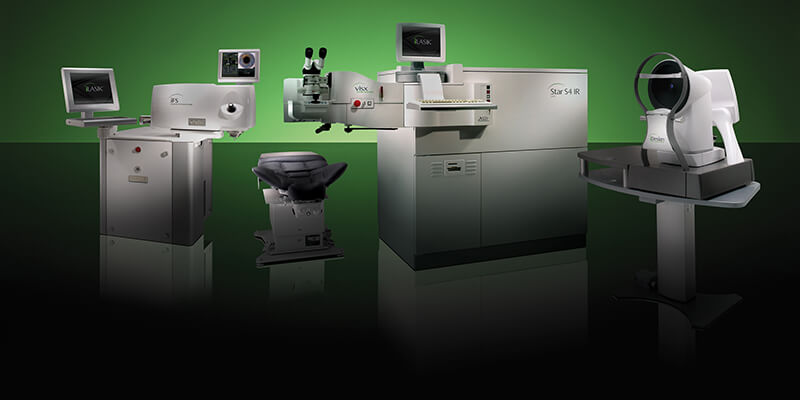
NOTE: Precise flap thickness is critical to successful LASIK outcomes.
How IntraLase works
(Intralase Answers 1-5 courtesy of IntraLase corp)
- IntraLase uses ultrafast pulses of laser light to position microscopic bubbles at a precise depth determined by your doctor.
- The laser light passes harmlessly through your cornea. Then the laser creating rows of these bubbles just beneath your corneal surface as it moves back and forth across your eye in a uniform plane.
- Next, the IntraLase laser stacks bubble around your corneal diameter to create the edges of your flap. These bubbles are stacked at an angle that is determined by your doctor and is individualized to the way your eye is shaped.
- The process takes only about 30 seconds from start to finish—it’s quiet and it’s comfortable.
- Your doctor then gently lifts the flap to allow for the second step of your LASIK treatment. When treatment is complete, the flap easily “locks” back into position and rapidly begins to heal.




